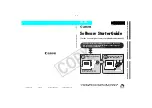
Language Elements
41
NetLinx Programming Language Reference Guide
Operator precedence
The table below shows the inherent precedence assigned to the operators. As noted in the chart, the
NOT
(!)
operator has the highest precedence in NetLinx systems but the lowest precedence in Axcess
systems. Axcess programs that are converted to NetLinx may exhibit logic problems if they use
statements that combine
NOT (!)
and other operators. Contact AMX Technical Support for help
resolving these issues.
Identifiers
An Identifier is a combination of letters, numbers, or underscores that represents a device, constant, or
variable. Identifier types include:
Devices
A device is any hardware component that can be connected to the NetLinx bus. Each device must be
assigned a unique number to identify it on the bus. While the Axcess language allows physical device
numbers in the range 0-255, the NetLinx language allows numbers in the range 0-32767. Device 0 refers
to the Master; numbers above 32767 are reserved for internal use.
NetLinx requires a Device:Port:System (D:P:S) specification where Axcess expected only a device
number. This D:P:S triplet can be expressed as a series of constants, variables separated by colons, or a
DEV structure. For example:
STRUCTURE DEV
{
INTEGER Number // Device number
INTEGER Port // Port on device
INTEGER System // System device belongs to
}
A device specification in NetLinx can be expressed in one of two ways:
Device Number: The compiler replaces the device number with an internally generated DEV
structure. This DEV structure contains the specified device Number. If the system and port
specifications are omitted (e.g. 128), system zero (indicating this system - the system
executing the code), and port one (indicating the first port), is assumed.
Operator Precedence
Level Operators
Associability
1
! ~
Left To Right
2
* / %
Left To Right
3
<< >>
Left To Right
4
+ -
Left To Right
5
< <= > >= = == <>
Left To Right
6
& | ^
Left To Right
7
&& || ^^
Left To Right
• Devices
• Device-Channel Arrays
• Device Arrays
• Level Arrays
• Channel Arrays
• Device-Level Arrays
Содержание NETLINX PROGRAMMING LANGUAGE
Страница 15: ...Table of Contents xiii NetLinx Programming Language Reference Guide...
Страница 16: ...xiv NetLinx Programming Language Reference Guide Table of Contents...
Страница 18: ...Introduction 2 NetLinx Programming Language Reference Guide...
Страница 76: ...Language Elements 60 NetLinx Programming Language Reference Guide...
Страница 106: ...Combining Devices Levels and Channels 90 NetLinx Programming Language Reference Guide...
Страница 112: ...Master To Master M2M 96 NetLinx Programming Language Reference Guide...
Страница 114: ...Mainline 98 NetLinx Programming Language Reference Guide FIG 1 Message and Mainline Processing in the NetLinx System...
Страница 182: ...Reserved Identifiers 166 NetLinx Programming Language Reference Guide...
Страница 204: ...NetLinx UniCode Functions 188 NetLinx Programming Language Reference Guide...
Страница 244: ...Appendix B Glossary 228 NetLinx Programming Language Reference Guide...
Страница 245: ...Appendix B Glossary 229 NetLinx Programming Language Reference Guide...
















































